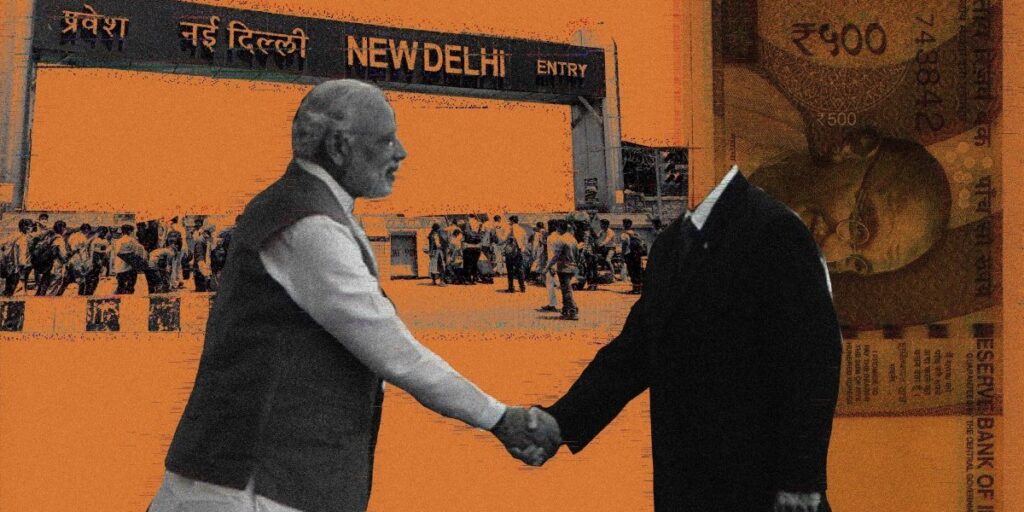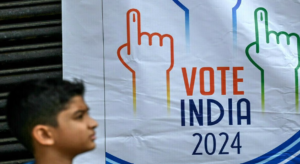[In an article published in ‘The Wire’ on 2 May 2024, the author reported on the Bharatiya Janata Party’s quicksilver accumulation of assets. Here is an extract from the article – we have made slight changes for style:
Ten years after the BJP came to power, Indians have no idea how deep the party’s pockets are – nor how this financial reserve was built.
However, a look at two prominent heads of expenditure by the party – its construction spree, and its campaign expenditure – throws up some indicative numbers. And suggest its officially declared income of Rs 14,663 crore between 2014 and 2023 is likely a gross understatement.
1. What is BJP spending on its new buildings?
In the past, Nadda has pegged the targeted number of new party offices as high as 900. It’s not clear, however, how many of these are coming up in towns and cities.
Even assuming the cost of these buildings (that is, district offices) (spanning land and building) has remained flat over the last eight years at Rs 3 crore — the party’s outlay works out to Rs 870 crore on district offices alone. For all 887 district offices, the party’s planned outlay works out to Rs 2,661 crore.
The party is also building larger offices in bigger cities… its Guwahati office has cost Rs 25 crore and the Bhopal office is expected to cost Rs 100 crore. Assuming one large office per state and Union territory — at Rs 25 crore apiece — nets us another Rs 900 crore. That adds up to Rs 3,500 crore.
That number could be higher.
2. How much is the BJP spending on election campaigning?
For the years between FY 2015-16 and FY 2022-23, the BJP’s annual reports peg electioneering costs (“Election/General Propaganda”) at a total of Rs 5,744 crore. However, independent studies, like the one from Centre For Media Studies (CMS), peg the party’s expenditure in the 2019 elections alone at “close to Rs 27,000 crore.”
Another large question has gone unasked here. According to CMS, the BJP accounted for nearly 45 % of the total expenditure by political parties – Rs 60,000 crore — in the 2019 national polls. The 2024 hustings are projected to cost twice as much — Rs 135,000 crore.
If the party’s spending share stays the same as in 2019, it will end up spending Rs 60,750 crore. Which works out to a total expenditure of Rs 87,750 crore between these two Lok Sabha elections. On the other hand, if it spends Rs 27,000 crore in 2024 as well, it will have spent Rs 54,000 crore in total.
And then, there are state elections.
India has a total of 4,123 state-level constituencies. In the last ten years, each of them has gone to polls twice. Even assuming an average expenditure of Rs 2 crore across each, that works out to Rs 16,492 crore on Vidhan Sabha elections.
With only the numbers for buildings and campaigning, the BJP’s expenditure adds up to:
- District offices: Rs 2,661 crore
- Other buildings: Rs 900 crore
- State elections: Rs 16,492 crore
- Lok Sabha elections: Rs 54,000 crore – Rs 87,750 crore
This works out to between Rs 74,053 crore and Rs 107,803 crore — five to seven times the party’s declared income of Rs 14,663 crore between 2014-15 and 2022-23. What is being caught with electoral bonds is not even 10% of that.]
❈ ❈ ❈
Last week, The Wire reported on the Bharatiya Janata Party’s quicksilver accumulation of assets.
Over the past ten years, not only has the party outspent rivals in polls and begun building new party offices in every district, state and union territory in India, it has also added to its cash reserves.
In effect, even as most Indians, hit successively by demonetisation, a botched rollout of GST, the Covid lockdowns and the skewed economic recovery that followed, slipped deeper into precarity, the party led by the Pradhan Sewak, as Modi had billed himself in 2017, is flourishing.
The BJP is not the only part of India’s polity to see an upswing in fortunes over the last ten years. So have a handful of firms, ranging from known conglomerates like Adani Enterprises and Reliance Industries to barely-known entities like Murari Lal Jalan (who acquired Jet Airways) and Nandal Finance and Leasing (which almost acquired PSU Central Electronics). And then are some heavyweights like Megha Engineering, Nirma, Solar Industries India Ltd, Raheja Corp and even Patanjali, who “have seen their fortunes surging in the last 10 years and either have direct contractual relationships with the government, or have benefited from seminal policies like land acquisition or infrastructure privatization”, writes Bloomberg.
The rise of India’s biggest firms needs to be understood.
Hardwired into that is an answer to the primary question citizens must ask every government: Cui bono? Who gained under you?
Exhibit A. National Champions
In 2014, shortly after the BJP came to power, it began to be said in India Inc that the government wanted to create five or six sectoral champions. The idea, as this reporter was told, was partly to curb Reliance Industries’ outsized influence on India’s political economy.
While new to India, this approach of “National Champions” is not an untested one. Countries like China, Korea and Japan too have groomed a handful of firms to world-beating scale. In 2018, an investment banker in Mumbai listed the firms he felt were being favoured — SpiceJet in aviation; JSW in Steel; Adani in utilities; Reliance in telecom; Dilip Buildcon in construction; Kotak in banking; Vedanta in mining; etc.
In the years that followed, enjoying state support — be it PLI schemes (like photovoltaic for Adani and Ambani); or the tweaks in airport policy that helped Adani enter airports — some of these groups have expanded furiously. Vedanta contemplated a diversification into chip manufacturing. Ambani’s telecom plans surged. Not only did Adani acquire hegemonic status in sectors like ports while growing in new sectors like data centres, airports and defence, it also pipped Ambani to briefly make Gautam Adani the richest Indian.
India’s push on national champions, however, is peculiar. The country didn’t see any discussion or white paper explaining why this shift in industrial policy was desirable. Nor was there any explanation as to which firms had been chosen — and why.
Compounding matters, the government’s support to some firms comes with corresponding coercion towards others.
Exhibit B. A newly coercive state
Between 2012 and 2014, this reporter had covered the infamous captive coal block allocation scam.
Most of us remember “coalgate”, as it was predictably dubbed. In the 2000s, the Atal Bihari Vajpayee government and then, the Manmohan Singh government, began handing out coal blocks for captive use — saying cheaper coal would result in cheaper electricity, making India more competitive.
What happened in practice was very different. Iron and steel firms cornered most coal blocks. Within the power sector, unknown firms trounced established rivals. Another set of firms bagged far more coal than they needed. As this reporter heard repeatedly at the time, firms with political connections — and those that bid the most in ‘shadow’ auctions — got blocks. Similar assertions were made also with Arunachal Pradesh’s abortive hydel boom. Here too, firms willing to pay bagged MoUs.
What India saw, along the way, was a non-discriminating crony capitalism. Companies with political links got what they wanted. And so did others. All that mattered was a willingness to pay.
But that is not how things have worked under Narendra Modi. Like the Congress, the BJP too has favoured a few firms. In a departure from the past, however, it has used coercion as well. Data released by the State Bank of India strongly suggests some firms may have been strong-armed through central agency raids into buying electoral bonds. The curious overlap in timing between state agencies cracking down on firms which the Adani group was trying to acquire has also been flagged.
As this reporter noted last year, “The charge now being made by businessmen and the opposition is that ruling parties are helping their preferred firms annex their peers.”
A third instance of this predatory shift in state-capital relations in India is the country’s bewilderingly stringent Insolvency and Bankruptcy Code.
Exhibit C. Insolvency, bankruptcy and unknown gainers
Do you remember Satyam Computers?
A peer of Infosys and TCS, the firm slipped overnight into crisis after promoter Ramalinga Raju announced he had been cooking its books. Decisive action by the erstwhile UPA government, which handed over the company’s management to a three-member board of respected IT industry folks like Kiran Karnik, kept Satyam’s flock of employees and clients intact till it was sold to a new management.
As the NPA crisis worsened during the mid-2010s, India needed a similar response.
Firms default on bank loans for multiple reasons. Each of these, a former REC (As Rural Electrification Corporation is known now) official told this reporter last year, needed a “detailed examination and specific counter-measures.” In the case of power plants, as he said, these counter-measures could have ranged from “working capital loans; securing coal supplies; arranging PPAs; completing construction; even criminal proceedings against promoters for fraud”.
With that, several of these firms could have been rescued — protecting both jobs and banks’ loans to these enterprises. What happened, however, was very different. As The Wire described last year, the BJP-led NDA created a very stringent Insolvency and Bankruptcy Code (IBC). It wanted, as the former REC official told us, “all projects to be processed through bankruptcy courts.”
The consequences have not been appreciated fully. By 2018, with even functional firms being taken to bankruptcy courts, the number of firms queued up at bankruptcy courts stood at 2,511. To put that number in perspective, India had no more than 7,000 firms with a topline over Rs 200 crore. With more firms up for sale than potential buyers, most firms have changed hands at a pittance. Jet Airways, as The Wire reported last year, was picked up by the Jalan Kalrock Consortium (JKC) which offered Rs 475 crore against Jet’s outstanding dues of Rs 24,888 crore.
As things stand, JKC illustrates a larger pattern.
A handful of Indian business groups — including some of the national champions — and global funds picked up choice firms at huge discounts, and amassed scale cheaply. So did a clutch of unknown firms like JKC. Despite the NCLT being empowered to pierce the corporate veil in order to ascertain the real successful bidder, several of these firms escaped scrutiny. In some cases, firms with unknown backers came in (google Worlds Window Impex, which tried to pick up one of Avantha Power’s thermal power projects in Chhattisgarh). Elsewhere, promoters mounted covert bids to reacquire their firms.
In all this, the government played a subjective role. Not only did it create a stringent bankruptcy code, it also selectively extricated some firms from bankruptcy courts while letting others slip into them.
The outcome? Not only has India Inc lived through its biggest change in ownership till date, it is not very clear who the winners are. Take JKC itself. Murari Lal Jalan is a UAE-based businessman few in the aviation sector had heard of. The other, Kalrock Capital, has been raided by Liechtenstein authorities on charges of suspected money laundering.
The losers are easier to spot. They include banks, employees, consumers and ordinary citizens. India’s aviation sector, for instance, lost Jet Airways. One fallout is a sector with lesser competition and higher prices, not to say rising instances of inefficiency. The economy, as a whole, saw extraordinary wealth destruction – as much as Rs 10.57 lakh crore in bank debt written off.
The costs don’t end there. Put national champions, an increasingly predatory state and the IBC together and you will see a fundamental reset in state-capital relations in India. What India has today is a model where the BJP calls the shots. Within capital itself, the country now has a two-tiered structure. “At the lower level are firms not favoured by the state. Above them are firms it favours. The second set grow fast. The first lot struggle. Both, however, know government support is necessary for them to do well. And so, a subservient relationship develops between state and capital.”
Much of this brings Russia to mind. There, the state decides who grows and who doesn’t.
Exhibit D. Other forms of cronyism
At least two of the modes described so far (national champions and the IBC) are new additions to India’s toolkit for crony capitalism. State-backed coercion has been around longer — as illustrated by Punjab.
Apart from the firms that gained through these instruments, older forms of crony capitalism have continued as well. There is divestment. PSU Central Electronics which, among other things, makes defence equipment, was nearly acquired by an unknown finance firm owned by a furniture company. Its promoters are said to be close to Uttar Pradesh BJP leaders. Only a Lokpal order seeking an investigation into CEL’s sale saved the PSU. Another instance of this pattern of no-name firms eyeing prestigious state assets? The unknown consortium that almost bagged Pawan Hans.
Another old staple — that of government tendering — has been milked as well. BJP Karnataka hit headlines for seeking a 40 percent commission from government contractors. And, as The Wire reported in 2022, Madhya Pradesh’s once-famous culture department, now overseen by BJP and RSS members, underpays artistes while handing out inflated event management contracts to one firm — Phoenix Networks – again and again.
The Narendra Modi government has also overpaid for overseas purchases. Rafale is one deal where such allegations have been made. Another is the odd matter where state-owned ONGC Videsh overpaid for Rosneft’s Vankor oilfield. Thereafter, Rosneft overpaid for Essar’s refinery and port in Gujarat, all at a time when Essar was trying to escape bankruptcy courts.
There is also the Modi government’s inexplicable embrace of imported gas. Instead of decarbonising faster, it is turning India into the last big market for expensive imported gas. It has even tried to force state-owned Petronet LNG — despite its board baulking at the deal — into tying up with US shale gas major Tellurian.
The government has never explained its reasons for wanting this deal so badly. Luckily for India, Tellurian slipped into trouble before the deal could be consummated. The larger push on Gas where India is committing to expensive imported gas purchases, however, continues. The accompanying risks, however, have barely been discussed.
Endgame
The BJP cannot be understood purely on the basis of its majoritarian politics.
Its financial decisions too are integral to any sensible attempt to comprehend the party. Here, an analogy to the Republican party is of use. In Let Them Eat Tweets, Jacob Hacker and Paul Pierson deliver a devastating summary of the modern-day Republican Party. It slips economic benefits to its funders and friends while pandering to the masses with non-economic benefits — bible, misogyny, xenophobia, the works.
Much of this frame applies to the BJP as well. As this article was being written, the 2024 elections are setting new lows in hate-messaging – like this video posted by the Karnataka BJP. In tandem, as this article — and the previous one on the party’s expenditure — show, the BJP’s friends and the party itself have gotten richer.
What India has seen over the last ten years draws comparisons with colonialism and neo-colonialism. Between the two, underlying trade relations didn’t change all that much. All that happened is that a better veneer came in. Something similar has happened with crony capitalism in India. It has just gotten more invisibilised.
Take a closer look, however, and you will see the same calculus of winners and losers. A few firms have gained – as has the BJP. “Knight Frank estimates that the number of ultra-high net-worth individuals in India — those with a net worth of $30 million or more — will jump 50% by 2028,” says Bloomberg. The costs, however, run deeper this time around.
A clutch of other businessmen are trying to not grow too fast — lest they become acquisition targets. Others are investing outside the country. As firms get liquidated or sold for a fraction of their value, IBC is resulting in huge wealth destruction. Between the crisis in MSMEs, the state unilaterally favouring a few firms, and their peers going slow on investments, joblessness is an accompanying outcome.
And then, there are all the risks that come with state-sanctioned monopolisation – ranging from economic inefficiency to the deepening of this pairing between a few firms and the government, with all its consequences for democracy itself.
(M. Rajshekhar is an independent journalist and the author of ‘Despite the State’. Courtesy: The Wire.)




